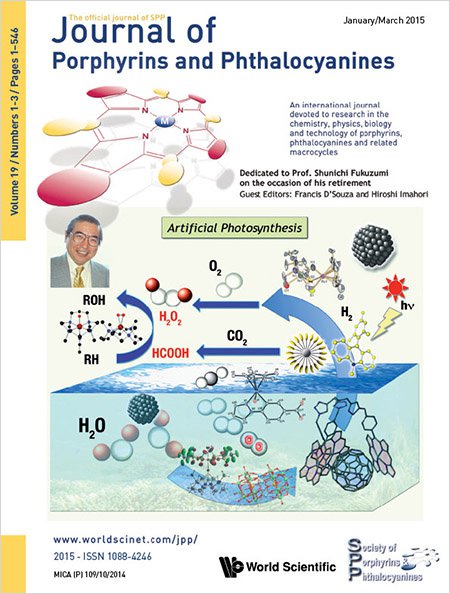Design of diethynyl porphyrin derivatives with high near infrared fluorescence quantum yields
Abstract
A design strategy for (porphinato)zinc-based fluorophores that possess large near infrared fluorescence quantum yields is described. These fluorophores are based on a (5,15-diethynylporphinato)zinc(II) framework and feature symmetric donor or acceptor units appended at the meso-ethynyl positions via benzo[c][1,2,5]thiadiazole moieties. These (5,15-bis(benzo[c][1′,2′,5′]thiadiazol-4′-ylethynyl)-10,20-bis[2′,6′-bis(3″,3″-dimethyl-1″-butyloxy)phenyl]porphinato)zinc(II) (4), (5,15-bis[4′-(N,N-dihexylamino) benzo[c][1′,2′,5′]thiadiazol-7′-ylethynyl]-10,20-bis[2′,6′-bis(3″,3″-dimethyl-1″-butyloxy)phenyl]porphinato)zinc(II) (5), (5,15-bis([7′-(4″-n-dodecyloxyphenylethynyl)benzo[c][1′,2′,5′]thiadiazol-4′-yl]ethynyl)-10,20-bis[2′,6′-bis(3″,3″-dimethyl-1″-butyloxy)phenyl]porphinato)zinc(II) (6), (5,15-bis([7′-([7″-(4″ ′-n-dodecyloxyphenyl)benzo[c][1″,2″,5″]thiadiazol-4″-yl]ethynyl)benzo[c][1′,2′,5′]thiadiazol-4′-yl]ethynyl)-10,20-bis[2′,6′-bis(3″,3″-dimethyl-1″-butyloxy)phenyl]porphinato)zinc(II) (7), 5,15-bis ([7′-(4″-N,N-dihexylaminophenylethynyl)benzo[c][1′,2′,5′]thiadiazol-4′-yl]ethynyl)-10,20-bis[2′,6′-bis(3″,3″-dimethyl-1″-butyloxy)phenyl]porphinato)zinc(II) (8), and (5,15-bis([7′-(4″-N,N-dihexylaminophenylethenyl)benzo[c][1′,2′,5′]thiadiazol-4′-yl]ethynyl)-10,20-bis[2′,6′-bis(3″,3″-dimethyl-1″-butyloxy)phenyl]porphinato)zinc(II) (9) chromophores possess red-shifted absorption and emission bands that range between 650 and 750 nm that bear distinct similarities to those of the chlorophylls and structurally related molecules. Interestingly, the measured radiative decay rate constants for these emitters track with the integrated oscillator strengths of their respective x-polarized Q-band absorptions, and thus define an unusual family of high quantum yield near infrared fluorophores in which emission intensity is governed by a simple Strickler–Berg dependence.

Dedicated to Professor Shunichi Fukuzumi on the occasion of his retirement.
Handbook of Porphyrin Science now available in 46 volumes


